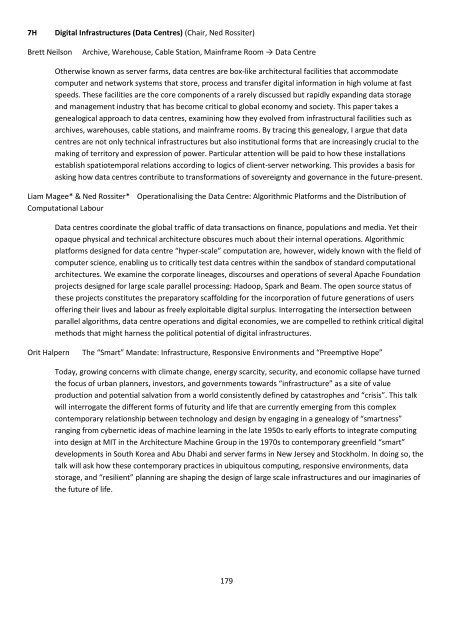Crossroads in Cultural Studies Conference 14-17th December 2016 Program Index
Crossroads-2016-final-draft-program-30-Nov
Crossroads-2016-final-draft-program-30-Nov
You also want an ePaper? Increase the reach of your titles
YUMPU automatically turns print PDFs into web optimized ePapers that Google loves.
7H<br />
Digital Infrastructures (Data Centres) (Chair, Ned Rossiter)<br />
Brett Neilson<br />
Archive, Warehouse, Cable Station, Ma<strong>in</strong>frame Room → Data Centre<br />
Otherwise known as server farms, data centres are box-like architectural facilities that accommodate<br />
computer and network systems that store, process and transfer digital <strong>in</strong>formation <strong>in</strong> high volume at fast<br />
speeds. These facilities are the core components of a rarely discussed but rapidly expand<strong>in</strong>g data storage<br />
and management <strong>in</strong>dustry that has become critical to global economy and society. This paper takes a<br />
genealogical approach to data centres, exam<strong>in</strong><strong>in</strong>g how they evolved from <strong>in</strong>frastructural facilities such as<br />
archives, warehouses, cable stations, and ma<strong>in</strong>frame rooms. By trac<strong>in</strong>g this genealogy, I argue that data<br />
centres are not only technical <strong>in</strong>frastructures but also <strong>in</strong>stitutional forms that are <strong>in</strong>creas<strong>in</strong>gly crucial to the<br />
mak<strong>in</strong>g of territory and expression of power. Particular attention will be paid to how these <strong>in</strong>stallations<br />
establish spatiotemporal relations accord<strong>in</strong>g to logics of client-server network<strong>in</strong>g. This provides a basis for<br />
ask<strong>in</strong>g how data centres contribute to transformations of sovereignty and governance <strong>in</strong> the future-present.<br />
Liam Magee* & Ned Rossiter* Operationalis<strong>in</strong>g the Data Centre: Algorithmic Platforms and the Distribution of<br />
Computational Labour<br />
Data centres coord<strong>in</strong>ate the global traffic of data transactions on f<strong>in</strong>ance, populations and media. Yet their<br />
opaque physical and technical architecture obscures much about their <strong>in</strong>ternal operations. Algorithmic<br />
platforms designed for data centre “hyper-scale” computation are, however, widely known with the field of<br />
computer science, enabl<strong>in</strong>g us to critically test data centres with<strong>in</strong> the sandbox of standard computational<br />
architectures. We exam<strong>in</strong>e the corporate l<strong>in</strong>eages, discourses and operations of several Apache Foundation<br />
projects designed for large scale parallel process<strong>in</strong>g: Hadoop, Spark and Beam. The open source status of<br />
these projects constitutes the preparatory scaffold<strong>in</strong>g for the <strong>in</strong>corporation of future generations of users<br />
offer<strong>in</strong>g their lives and labour as freely exploitable digital surplus. Interrogat<strong>in</strong>g the <strong>in</strong>tersection between<br />
parallel algorithms, data centre operations and digital economies, we are compelled to reth<strong>in</strong>k critical digital<br />
methods that might harness the political potential of digital <strong>in</strong>frastructures.<br />
Orit Halpern<br />
The “Smart” Mandate: Infrastructure, Responsive Environments and “Preemptive Hope”<br />
Today, grow<strong>in</strong>g concerns with climate change, energy scarcity, security, and economic collapse have turned<br />
the focus of urban planners, <strong>in</strong>vestors, and governments towards “<strong>in</strong>frastructure” as a site of value<br />
production and potential salvation from a world consistently def<strong>in</strong>ed by catastrophes and “crisis”. This talk<br />
will <strong>in</strong>terrogate the different forms of futurity and life that are currently emerg<strong>in</strong>g from this complex<br />
contemporary relationship between technology and design by engag<strong>in</strong>g <strong>in</strong> a genealogy of “smartness”<br />
rang<strong>in</strong>g from cybernetic ideas of mach<strong>in</strong>e learn<strong>in</strong>g <strong>in</strong> the late 1950s to early efforts to <strong>in</strong>tegrate comput<strong>in</strong>g<br />
<strong>in</strong>to design at MIT <strong>in</strong> the Architecture Mach<strong>in</strong>e Group <strong>in</strong> the 1970s to contemporary greenfield “smart”<br />
developments <strong>in</strong> South Korea and Abu Dhabi and server farms <strong>in</strong> New Jersey and Stockholm. In do<strong>in</strong>g so, the<br />
talk will ask how these contemporary practices <strong>in</strong> ubiquitous comput<strong>in</strong>g, responsive environments, data<br />
storage, and “resilient” plann<strong>in</strong>g are shap<strong>in</strong>g the design of large scale <strong>in</strong>frastructures and our imag<strong>in</strong>aries of<br />
the future of life.<br />
179


